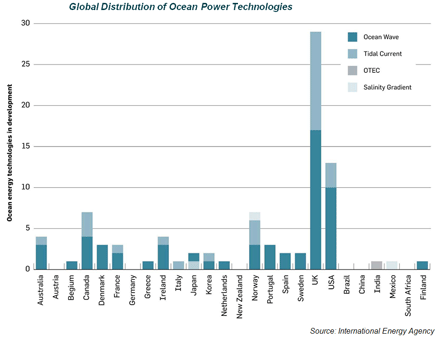
The Potential of Ocean Power
Mar 25, 2009 - Daniel Englander - energycentral.com
 |
Daniel Englander
research associate
Greentech Media |
Ocean power is 832 times denser than the air flowing over wind turbines as tidal waves are predictable up to the minute at least 100 years in advance. Understandable and rapidly declining costs coupled with high performance and output are the primary factors that will drive down the levelized cost of energy for ocean power technologies in the long term. In this report, Greentech Media and the Prometheus Institute for Sustainable Development address the underlying fundamentals that will determine when ocean power technologies will become competitive with other renewable and traditional energy sources, what technologies will bring the industry to that point, and how investment, government policies, and power sector buy-in will drive the growth of this industry.
While today fewer than 10 MW of ocean power capacity has been installed worldwide, we believe that in six years the industry has the potential to break 1 GW of installed capacity on an annual market size of over $500 million. More than $2 billion will be invested in that time in commercial production and installation. Based on current trends, a similar amount will be invested in research, design and development during that time.
Ocean Power Technologies
Ocean power technologies occupy a unique space in the world of renewable energy. The majority of devices are fairly new, notwithstanding the burst of technology development that occurred from the mid-1970s to the early 1980s. Designs from the first ocean power development boom focused largely on ocean thermal energy conversion and salinity gradient conversion. Most current designs have their origins in the late 1990s or early 2000s. Wave Dragon's overtopper, the oldest of the modern technologies, was conceived in 1986 by founder Erik Friis-Madsen as he watched water flow through the holes of a reef on a Pacific atoll.
Despite their status as early-stage or emerging technologies, many in the industry regard ocean power devices as an extension of technology developed in the offshore oil and gas, wind power, and shipbuilding industries. In fact, nearly every wave and tidal company has an engineer, designer, or founder with a hydraulic or marine engineering background and many have borrowed heavily from technologies and components developed in these industries.
Technology transfer between traditional marine and wind industries and the ocean power industry has allowed many companies to move rapidly into advanced research and development. Compared with other renewable energy sectors, such as solar or advanced storage where materials and chemical research often consume a disproportionate amount of time and investment capital, ocean power companies often dedicate a majority of their early-stage work to combining mechanical and electrical systems and proving device survivability and performance. As such, the development bottleneck in ocean power often occurs in the scaling-up stage and not the device design stage.
In 2006, the International Energy Agency identified 81 individual ocean power projects ranging from university and government-backed research programs to companies on the verge of commercial deployment. The United Kingdom was the leading developer with 29 individual projects while the United States was second with 13. Other leading countries include Australia, Ireland, Canada and Norway.
Wave Power
Wave energy technologies are the most heavily researched and funded sector in the ocean power industry. Out of the 35 companies analyzed in this report, 24 are developing wave energy technologies. This is likely due to the scale and availability of the ocean wave resource when compared to the marine current and tidal stream resource. The potential to bring renewable electricity to the nearly 50 percent of the world's population living within 60 miles of a coastal area is another factor driving the outsized development of wave energy technologies.
The majority of companies developing wave energy technologies are working on devices called point absorbers. Point absorbers resemble offshore buoys that mark channels and measure environmental and meteorological data, though they are much larger. These devices are researched and developed at a higher rate than other kinds of wave energy devices because of their ability to absorb energy from oncoming waves in all directions. Their behavior is much the same as that of a cork in a bathtub, bobbing in reaction to multidirectional ripples. All other wave energy devices are designed to absorb oncoming energy from only one direction or dimension in space. Multidirectional absorption, however, is not without its problems. The device must be tuned to the wave climate in which it is submerged, or energy created will not flow smoothly through the power take-off system. Some companies have developed advanced tuning systems, while others have overlooked this critical issue.

Tidal Power
Tidal energy technologies have received relatively less attention than wave energy technologies, despite their comparative success in commercial deployment and lab and in-water testing. Of the 35 companies analyzed in this report, only 11 are developing tidal energy technologies. While geography is a limiting factor in the deployment of tidal energy devices, in the future this may be mitigated by some of the more promising aspects of this method of power generation.
In addition to the obvious technology transfer possibilities from the wind industry to the tidal industry -- the link here is much clearer than the technology transfer link between wave power and the offshore oil and gas industry -- tidal energy provides an exceptionally predictable source of power. Since tides are a function of lunar phasing, it is possible to predict incoming tidal power hundreds of years in advance.
Of all the renewable energy technologies, with the possible exception of geothermal power, tidal power is the most predictable and reliable. This could help in alleviating, though not solving entirely, the problem of dispatchability that many power companies and utilities cite as a reason for not adopting renewable energy technologies. The majority of tidal energy companies are developing horizontal axis turbines. In many ways these are analogous to both land-based and offshore wind turbines, and the general shape, mounting and fixing technology, and power take-off system design are essentially the same. There are, however, several critical differences: Size is by far the most important factor separating horizontal axis turbines operating in the water from horizontal axis turbines that harness wind power. Tidal turbines generating 1 MW of power may have rotor diameters roughly one-third the size of a wind turbine with a comparable nameplate rating.

|